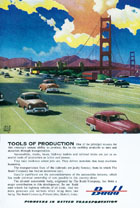|
|
Dodge had produced the world’s first four door all-steel sedan, followed a few years later by an all-steel coupe. With the success of the Dodge Brothers cars, the other makers were now starting to take notice of the Dodge-Budd partnership. By 1925, Dodge had built well over one million cars.
Hudson-Essex were one of the first to switch over to steel bodies and went to Budd for their supply. However, it wasn’t long before they began to make their own bodies using Bud’s principles of construction. By the end of the 1920s, more than six million US cars now had all steel bodies.
During this period, European makes began to take notice of US developments in body construction. In 1925, William Morris (Lord Nuffield) went to Philadelphia to learn about this innovation. Upon returning, he set up the Pressed Steel Co. in Cowley. It was the first steel car body plant in Britain, largely financed and overseen by the Budd Co. Not only did Morris Minors have bodies from them, but even Rolls Royce sought their steel products too.
On the continent, Citroen was licensed to build Budd bodies for their cars, the first continental maker to do so. The Citroen-Budd collaboration produced the first integral designed car, with Citroen prototypes having been built by Budd.
Louis Renault helped himself to Budd’s patented processes knowing the French courts wouldn’t likely uphold infringement of patents. However, Budd sued them in the German courts instead. Budd’s patents were world wide and anyone seeking to build all steel bodies would inevitably come up against them. Budd, via the Ambi-Budd Presse Werke, won his case against Renault in Germany. Renault was forced to pay royalties like everyone else.
Wood had still a place in all-steel bodies in supporting the car’s roof. But in 1935, the advent of the turret top removed this role from wood. Though some makers still clung to composite wood-steel construction, the timbered car’s days were all but over. Unitised construction was the only way ahead for the mass-production market.
Budd was still involved with railroad car and locomotive construction with stainless steel being Bud’s new passion. In the 1930s, the streamlined trains started to make their appearance. Their higher speeds meant better braking was required and Budd’s development moved towards disc braking systems; first for trains and later, cars.
While automotive pioneers such as Ford, the Dodge brothers, Chevrolet, Olds, Buick, and Studebaker had made notable contributions to car history, the work of Edward Budd had revolutionised an industry on a global scale. The automobile’s long association with the wagon and carriage makers had now been broken with the visions of one man. Edward Budd died November 30, 1946 in Pennsylvania.
From America’s first capital we had two innovative men with visions of the future and an interest in presses. With Ben Franklin, it was of the printing variety; with Budd, it was pressing steel. Franklin laid the foundations on how America would be built as a nation. Budd laid the foundations of how its cars would be constructed. |
|
 |